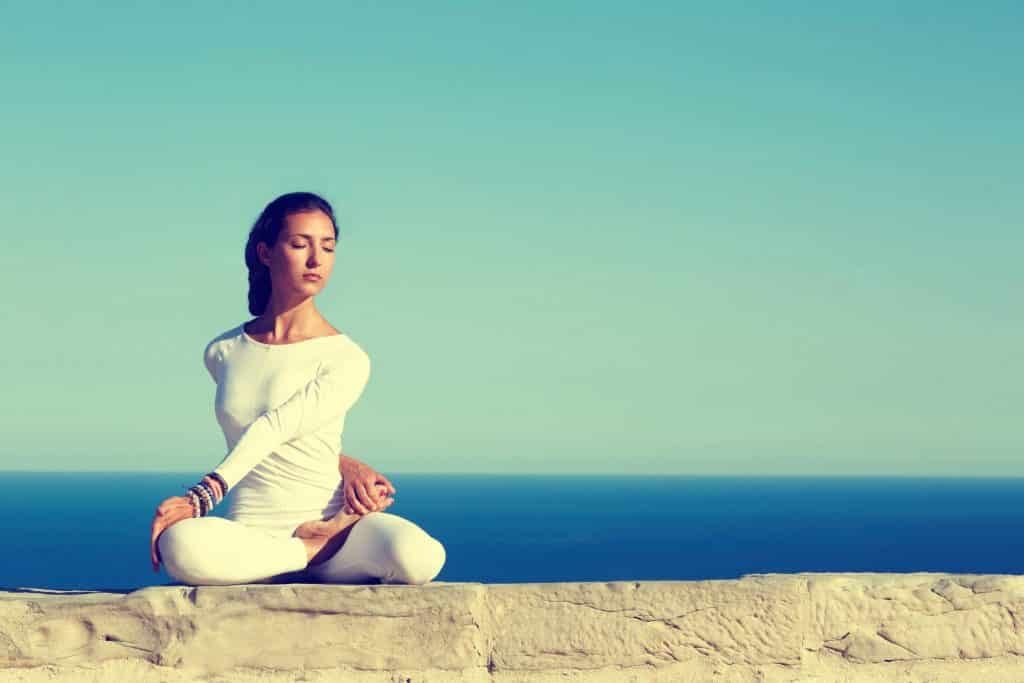Restorative yoga is a slower-paced form of yoga than the styles most people would be familiar with in the West. It takes a healing, meditative approach to the ancient practice and has been less popular than other, more dynamic forms of yoga over the decades because of its slower pace. That is changing, however, and it is beginning to gain a significant following as people start to see its value. Recent studies have shown restorative yoga can aid weight loss, benefit the immune system, banish stress, and improve overall health and quality of life. And as the pace of life gets faster and busier, giving yourself the time to slow everything down for an hour with some restorative yoga poses becomes more and more beneficial…

What Is Restorative Yoga?
As the name suggests, restorative yoga is, well, restorative. It asks us to do what we are so bad at doing in the Western world: slow down, reflect, heal and recuperate. The practice emphasizes relaxation over flowing movements and physically challenging poses, instead focusing on simple stretches. There is a lot of focus on centering the breath and body, practicing stillness along with gentle movements, and holding poses for extended periods.
Part of the reason it has not been as popular a choice as more dynamic styles of yoga is because people have a short window of time each week to include exercise into their routine, and restorative yoga doesn’t look as beneficial from the outside as yoga that makes your muscles burn and your glands sweat.

Restorative yoga uses a lot of props, including blocks, bolsters, blankets and beanbags, to help you comfortably hold stretches and poses for longer periods of time than the more active yoga styles. It is a much more therapeutic and relaxing practice, but that doesn’t mean it is ‘easy’ or lacks the benefits of faster-paced styles…
Benefits Of Restorative Yoga
Although the thought of minimizing effort to reap physical and mental rewards may seem alien to Western yogis, there is mounting proof that suggests this form of yoga has a number of incredible health benefits. Science has discovered that restorative yoga is even better than sleep for releasing muscle tension, reducing joint pain and calming the mind. It decreases the stress hormone, cortisol, which is associated with weight gain, high blood pressure and heart disease when constantly released due to anxiety or persistent worrying.

Restorative Yoga Can Reduce Stress
Restorative yoga poses allow you to find out where your body holds tension. For example, many women carry tension in their hips. It sounds like a metaphor, but the link between the hips and emotions is real and quite fascinating.
The pelvis area is made up of bone, muscles, tendon, ligaments and fascia, and it is a central point in the body, used to stabilize, support and control motion. The hip flexor muscles are large and are usually held in position, when standing up or sitting down for long periods of time, causing them to be quite tight. But tight hips aren’t just the result of extended periods of sitting or standing – they can also be signs of stress. During a moment of fear, when stress hormones are released, the body’s natural instinct is to clench those deep muscles, and the problem is, constant clenching with no counteractive releasing causes them to store that stress. Restorative yoga poses focus on stretching and opening muscles, releasing tension and stress in the body. Hip-opening restorative yoga poses use some of the best techniques to release that build-up of emotion.
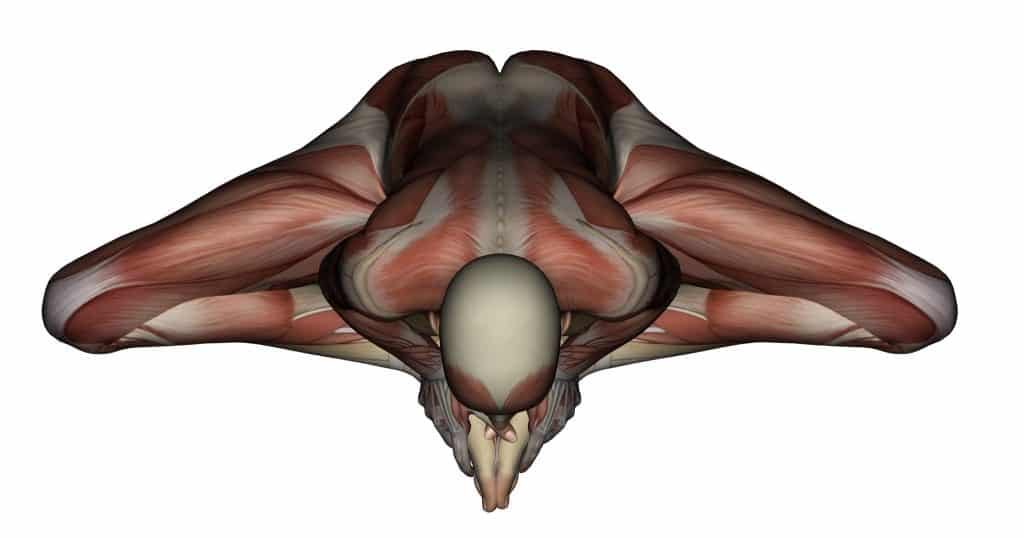
Aid Weight Loss
This is the one that came as quite a surprise to the fitness community. Everything we’re taught growing up about weight loss is that it is about eating small amounts of healthy food and torturing your body with strenuous exercise. It’s basically the polar opposite to slowing everything down and resting, which is what restorative yoga is based on. Strenuous exercise and eating healthy, of course, both have their benefits to weight loss, but the interesting thing is that restorative yoga does too. A 48-week study from the University of California in San Diego found that restorative yoga helped overweight women trim subcutaneous fat, and, in fact, they lost more weight than overweight women practicing more active stretching sequences. This may be because of the effect restorative yoga has on reducing cortisol levels, with high levels of the stress hormone linked to increased stubborn tummy fat.
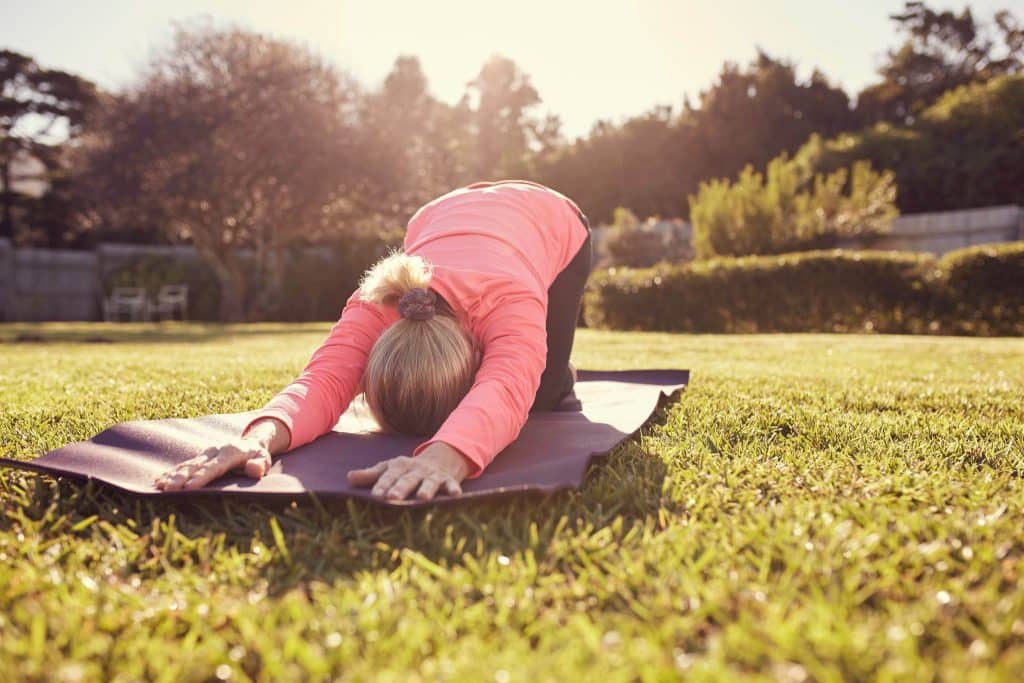
Increase Flexibility
Yoga is a well-known flexibility enhancer, but restorative yoga is not focused on how bendy you can get after a certain number of sessions, like some other forms of yoga have become subjected to. Instead, restorative yoga focuses on what happens when you release tension in the body, in areas that have been tight and unopened. As a result of deep, elongated stretches, restorative yoga can actually increase flexibility faster than other flowing dynamic forms of yoga.
Help Illness And Injury Recovery
Restorative yoga allows people who might be partially immobile or recovering from certain injuries or illnesses to benefit from exercise, while they are unable to practice more strenuous workouts. Restorative yoga can be customized to suit individual needs and allows people with low energy or depleted strength to enjoy some exercise and stretches. For example, someone suffering from a broken bone can still practice restorative yoga using other parts of the body and focusing heavily on the breathing and meditative parts of the practice.
People who have suffered illnesses like a bad bout of the flu virus or chronic fatigue can really benefit from restorative yoga, when they may not be able to manage more active, flowing asanas or other forms of exercise. Not only will it get their body moving, keeping them mobile and stretched, but its restorative, restful and stress-reducing benefits will actually aid in the recovery.
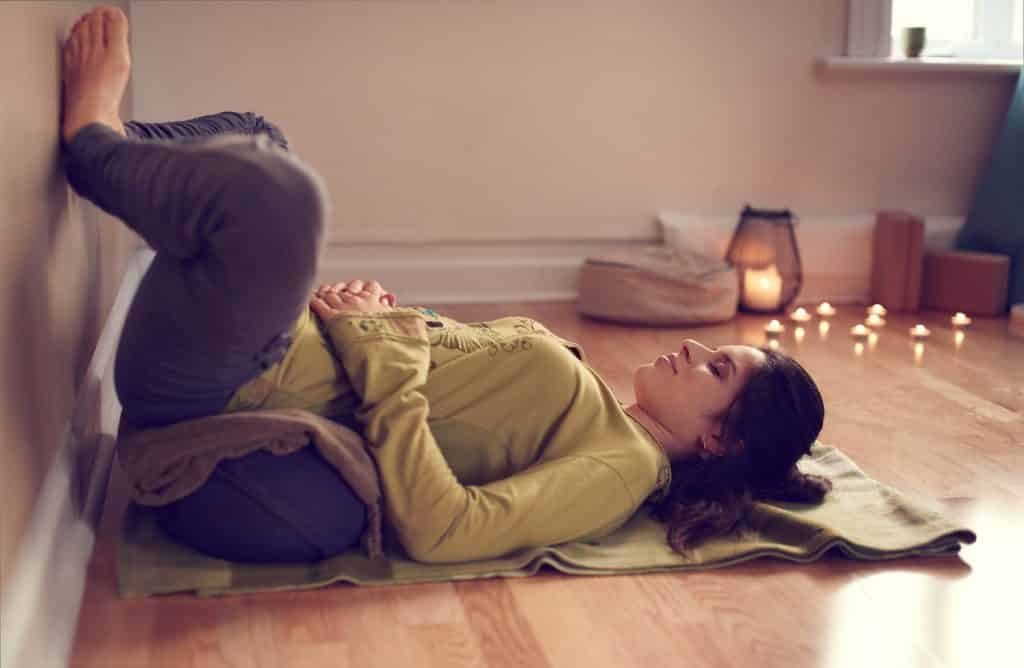
Calm The Nervous System
By slowing down for an hour and practicing deep breathing and relaxation, restorative yoga poses can actually trigger the parasympathetic nervous system. This helps alleviate the effects of our regular stress responses in everyday life, which can be extremely damaging to our physiology and overall health. The calming effect of restorative yoga on the nervous system allows your body to reach a state of repair, where it can renew and rejuvenate during deep relaxation.
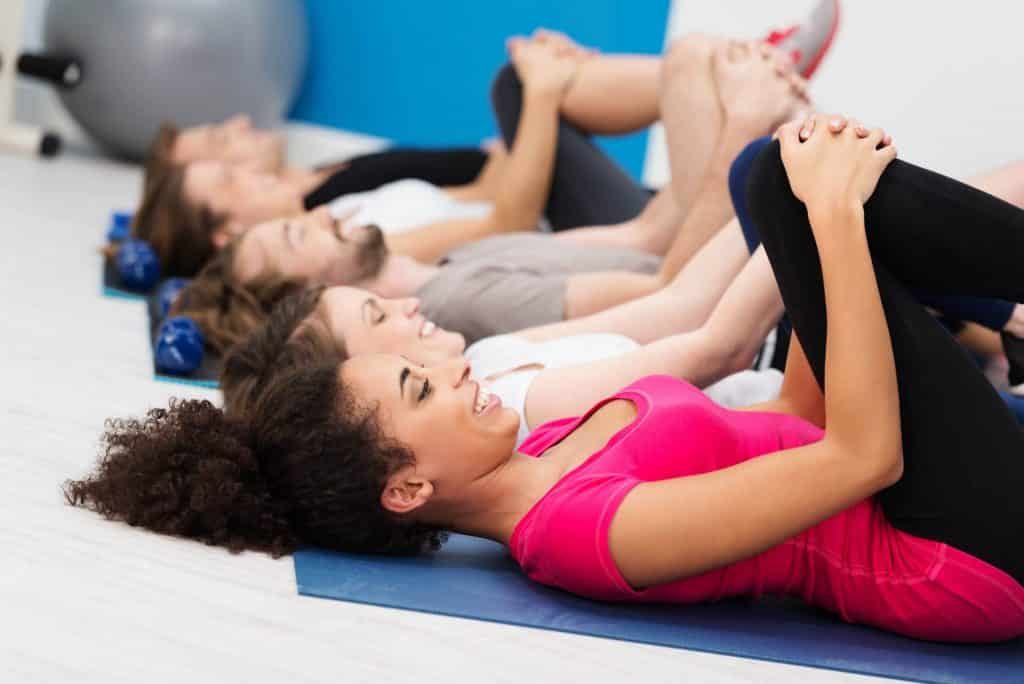
Support The Immune System
Alongside its ability to calm the nervous system, restorative yoga has also been found to support the immune system and the body’s adrenalin function. A US study found that yoga has measurable rapid effects on gene expression patterns in circulating immune cells. The results show that significant gene expressions in participants can change rapidly within two hours of starting a yoga practice. Researchers found that yoga has an integral physiological component at a molecular level, which is immediately initiated during a yoga sequence, and may form the basis for long-term stable effects.

Calm The Mind
Restorative yoga can have an enormously calming effect on an overstimulated, overactive mind. But it may take a while to get there. The poses immediately move your body into a restful, restorative state, but getting the mind to that place can be a bit more difficult. Restorative yoga can give you the tools and atmosphere to reach a state of calm within the mind, and, over time, you will learn how to move towards stillness in the present moment. By moving into poses slowly and holding them for longer periods of time than in other, more active forms of yoga, a restorative practice can help you become more mindful. You will be more aware of the physical sensations of each pose and how it feels on certain muscles and joints, as well as being more aware of your breath. Studies have found that a consistent yoga practice can significantly increase serotonin levels and decrease monamine oxidase levels, which is an enzyme that breaks neurotransmitters. As a result, yoga has the potential to decrease depression, stress and anxiety.
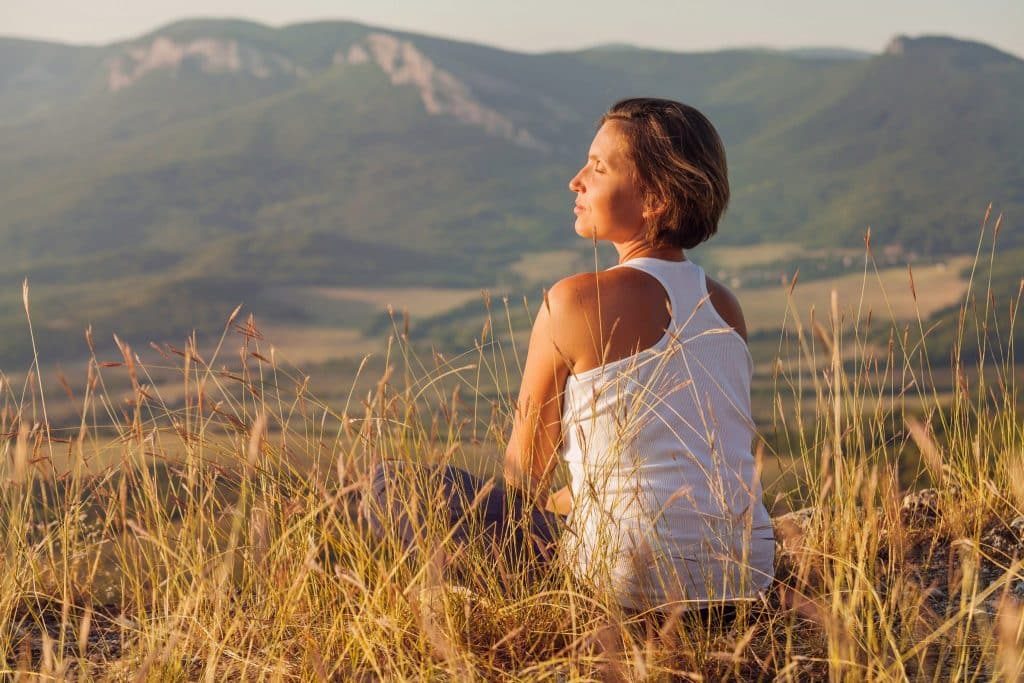
8 Of The Best Restorative Yoga Poses
Restorative yoga poses can be used in a sequence or on their own. You will usually practice far less poses in a restorative yoga class than a dynamic class, because more time is spent moving into a pose and holding it, and more time is also spent at the beginning and end of the class on breathing techniques and meditation or relaxation. It is common to use props for restorative yoga poses to allow the body to be more comfortable in each position, and to help you hold the pose for longer. To begin with, practice yogic breathing, which you can then continue throughout the class, pairing movements with your breath…
Reclining Bound Angle Pose (Supta Baddha Konasana)
This is a wonderful hip-opening pose that can help release tension in the hips and pelvis area, open the chest, increase blood circulation, improve digestion, stretch the inner thighs and calm the nervous system.
Props can be very useful for this pose, and there are a few different options here. To move into reclining bound angle without props, simply lay flat on your back and open your hips, allowing your knees to gently rest outwards. Place the soles of your feet together and let your hands rest on your belly, by your sides, palms facing up, or above your head.
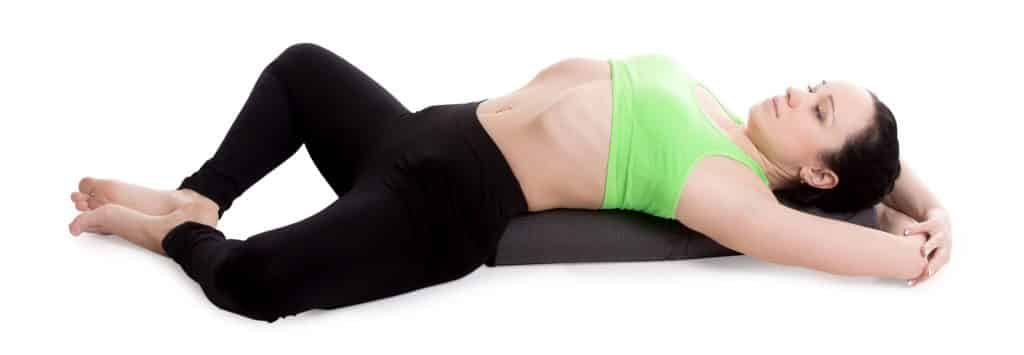
Variations: If the stretch is too much for your inner thighs or hips, place a block or rolled up blanket underneath each knee.
To open the chest more and re-energize the body, place a bolster along the spine, starting at the tailbone, and make sure your head is supported, either by the bolster or a pillow.
To reverse circulation from the feet, place a beanbag underneath the legs so that your buttocks and upper body are on the mat and your legs and feet are elevated.
Reclining Big Toe Pose (Supta Padangusthasana)
This pose releases the muscles in the backs of the legs and improves flexibility in the legs. It is a therapeutic pose that stretches the hips, thighs, groin, calves and hamstrings, strengthens the knees and relieves back aches, sciatica and period pain. It can also be a calming pose for people with high blood pressure.
Start lying on your back with your legs extended. As you exhale, bend one knee and hug it into your chest. Loop your strap around the arch of your foot, holding one end of the strap in each hand. On an exhale, extend the foot towards the ceiling, pushing the heel upwards. Keep the knee slightly bent if you feel a stretch without fully straightening the leg. Keep inhaling and exhaling, and as you breathe out, you might be able to move a little more towards straightening it. Repeat on the other side.
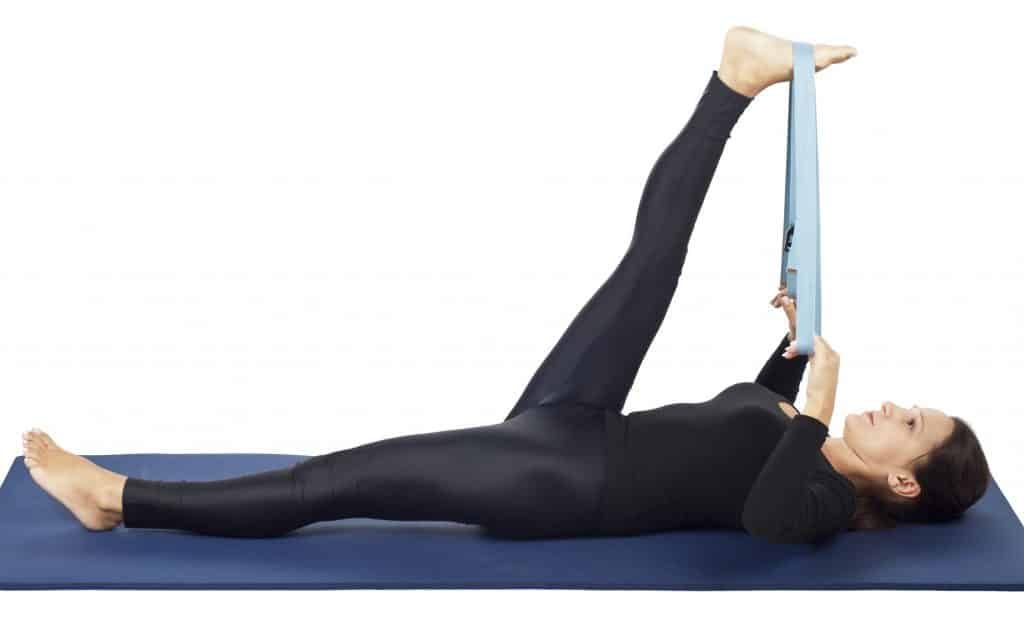
Child’s Pose (Balasana)
This is a restorative pose that is often used in all styles of yoga to rest and calm the mind. It gently stretches the legs, ankles and hips while relieving stress and fatigue and releasing tension in the back and neck.
Start in tabletop position with your wrists directly under your shoulders and knees underneath your hips. As you exhale, slowly sit back onto your heels, moving your torso in between your thighs and allowing your arms to stretch out. Rest your forehead on the mat. You should feel a stretch along your back, and between your shoulder blades.
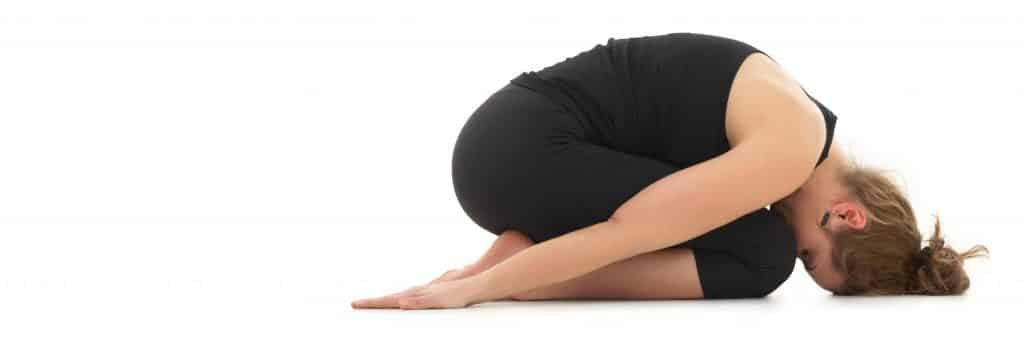
Variations: If your buttocks doesn’t comfortably reach your feet, place a folded blanket on top of your legs and sit back onto that.
For wide angle child’s pose, place some blankets or a pillow in between your legs and lay your torso on top.
If your forehead doesn’t comfortably reach the mat in child’s pose, place a pillow or folded blanket on the mat and rest your head on that. You can turn your head in either direction and rest on your cheek if that is more comfortable.
If your shoulders or arms are sore, you can rest them alongside your body instead of extending them out in front.
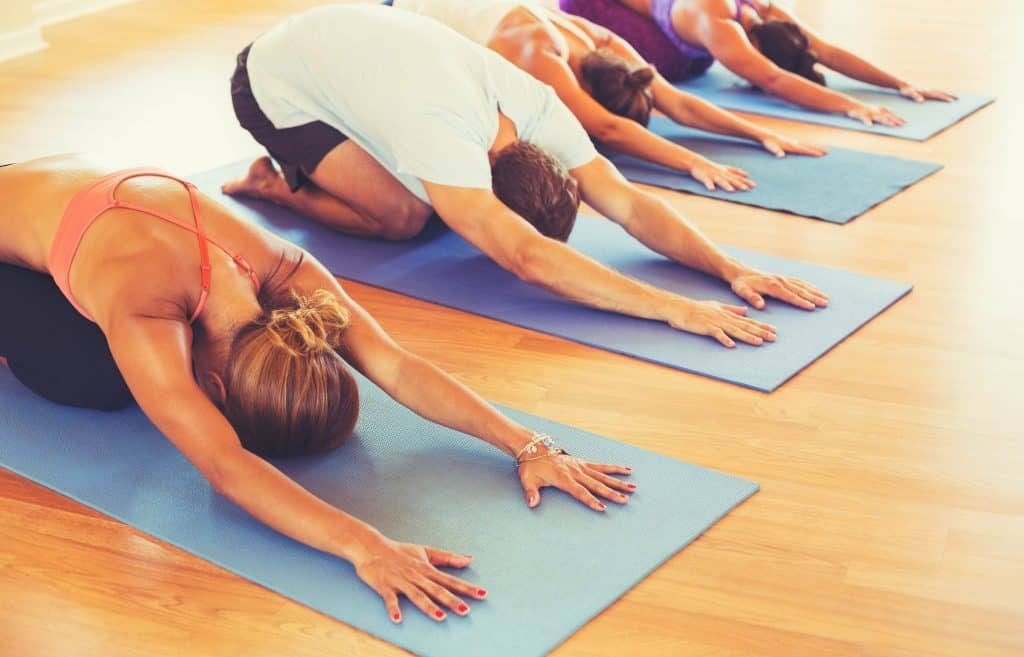
Reclining Hero Pose (Supta Virasana)
This is an extremely relaxing pose that stretches the abdomen, thighs and psoas, which are the deep hip flexors. It relieves tired legs, improves digestion and opens the chest.
Start in Virasana, sitting in between your legs. To achieve this, gently pull your calf muscles outwards and have your feet on either side of your buttocks. If this puts too much pressure on your knees, scroll down to the variations and follow those instructions. On an exhale, lower your back towards the floor, leaning back on your hands. If that’s enough of a stretch for you, stay in that position, otherwise you can stretch a little deeper, leaning back onto your forearms and elbows. Again, if that’s enough of a stretch, stay in that position, otherwise you can lay all the way back with your arms by your sides, or extended over your head.
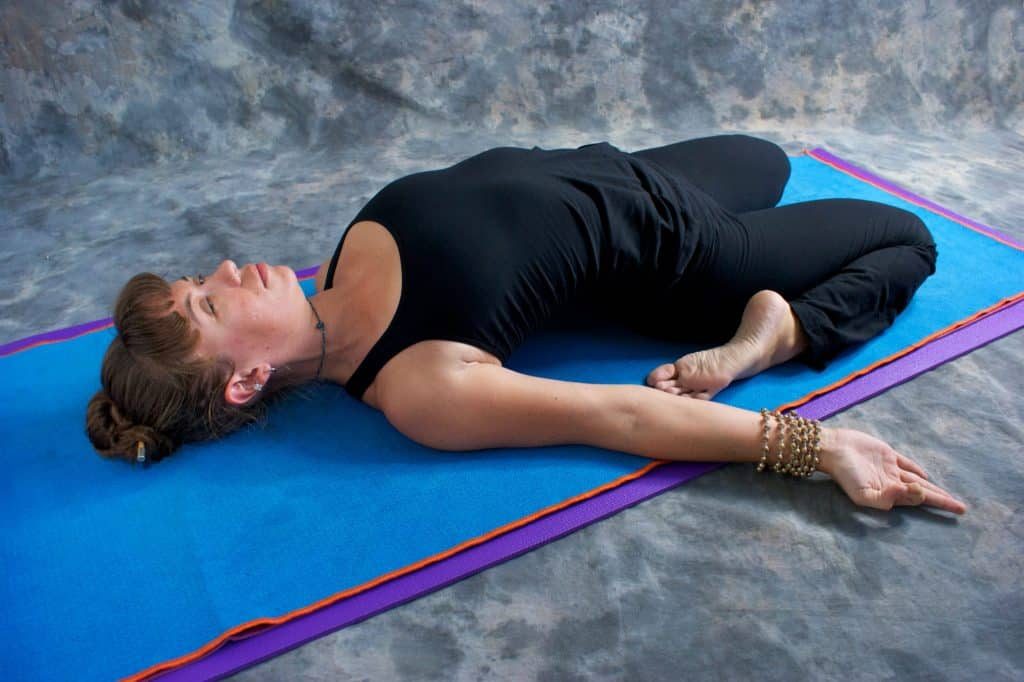
Variations: This is a great one to use props in. You can put blocks, pillows and rolled up blankets between your legs to sit on. This will prop you up if the pose isn’t comfortable on your knee joints.
If you don’t want to stretch your back all the way onto the ground, you can lean back onto a beanbag and relax, stretching your legs.
If you want to make this pose more of a heart opener, you can put a bolster along your spine and allow your shoulders to float down either side of it.
Pigeon Pose (Eka Pada Rajakapotasana)
This is an incredibly powerful hip-stretching pose that can relieve built-up tension and stress from the area. Because these deep large muscles are often kept mobile in a seated or standing position, and clenched when we tense up, this pose can cause an extremely strong sensation in the area that can, at first, be quite uncomfortable. Over time, as you practice more yoga and relax into this pose, the sensation will become a little less intense. If you’re new to yoga, it’s definitely advisable to use props for this pose to support yourself. You should also be warmed up for pigeon pose because it is so intense.

Start in tabletop position with your hands shoulder-distance apart and bring one knee forward, placing it on the mat just behind and outside your hand. Your shin should be on a diagonal with your foot towards your groin, and the inside of the leg should be facing upwards. Your back leg and hip should be facing the ground. Use your back toes to lift the leg and slowly work it backwards so that it is straight on the mat, until you feel a deep stretch along the hip and buttocks muscles of the front leg. Take a few breaths and relax into the pose. If this is enough of a stretch, remain with your hands on the mat and chest up, otherwise you can lower your upper body towards the mat, leaning on your forearms, or resting your arms above you and placing your forehead on the mat. Take your time in this pose – if you can stay in it for a few minutes, the muscles will relax more and the stretch will be more beneficial. Repeat with the other leg.
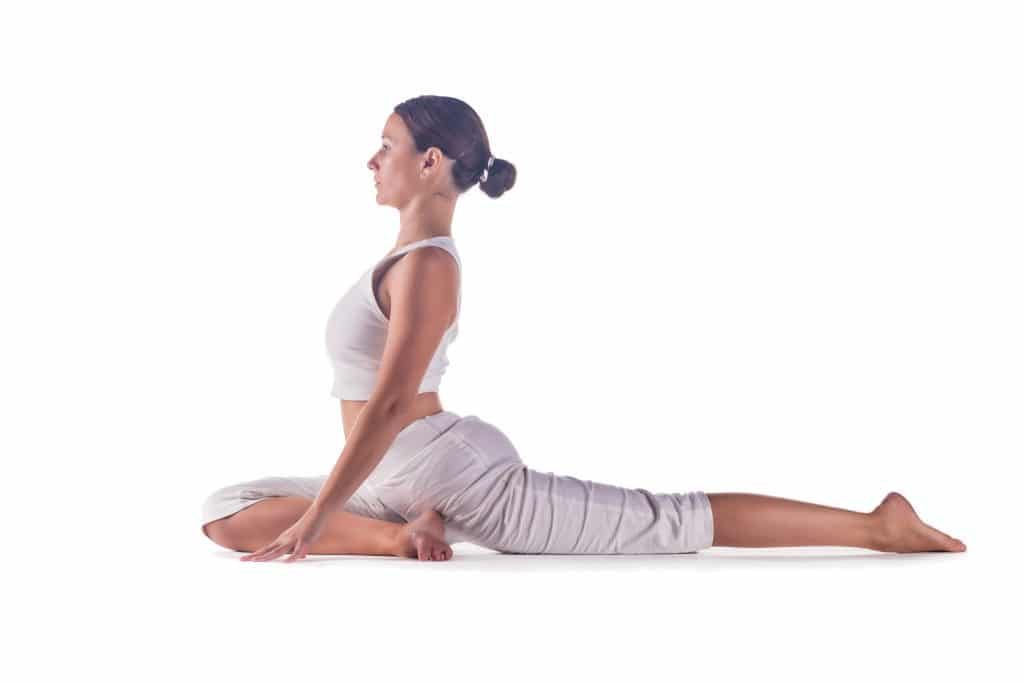
Variations: Because this is such a strong pose, it’s a good idea to start with props. You can use a cushion or folded blanked underneath your pelvis and buttocks to support the stretch and prop you up.
If you want to open the chest in this pose, and stretch the thigh of the passive leg, you can curl the back leg up and take hold of it with your hand, opening the chest and stretching the front of that leg.
Happy Baby Pose (Ananda Balasana)
This is a very gentle, restorative pose that is often used towards the end of a yoga class to stretch the inner groin area and to stretch and relax the back. It is a calming pose that can also help relieve fatigue and stress.
Start on your back and, as you inhale, take hold of the soles of your feet with your hands and open your knees a little wider than your torso. Bring your knees towards your armpits and move around in whatever way makes your body feel good. You can massage your back by gently rolling from side to side, or you can straighten your legs a little and move them up and down.
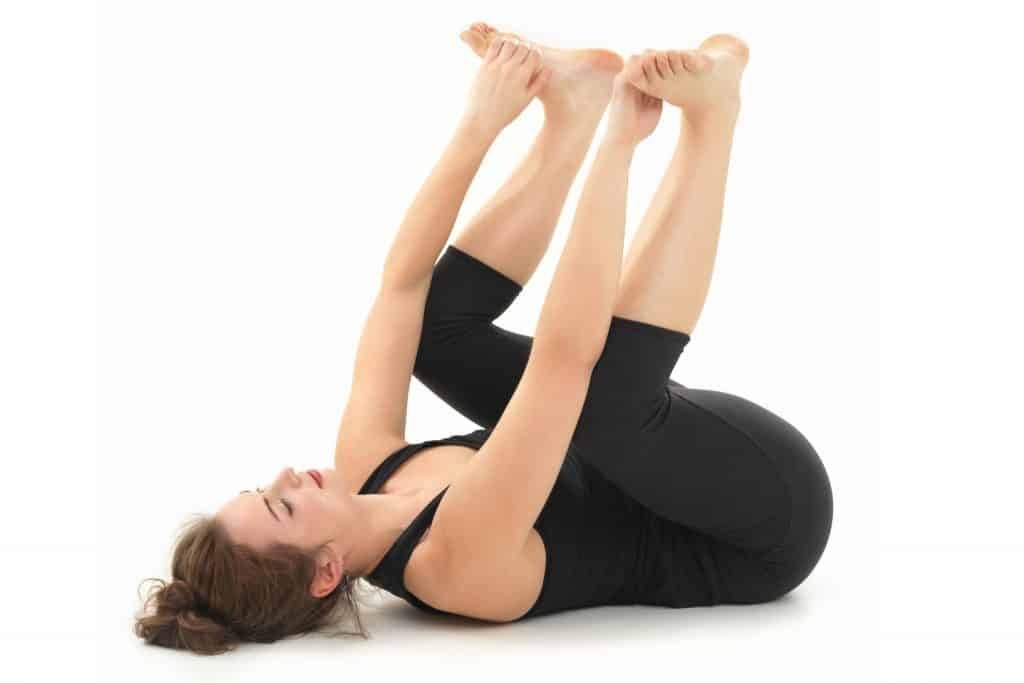
Variations: There aren’t many variations here, but if you can’t reach your feet with your hands comfortably, you can use a strap. Just place the strap around the soles of your feet and hold each end with your hands.
Universal Spinal Twist (Shava Udarakarshanasana)
This is another great restorative, wind down pose that relieves stress and stiffness in the lower back and hips, and stretches the spine, improving its movement and mobility. Twisting poses like this one are also good for digestion.
Start on your back and bend your knees on an inhale. Spread your arms out to either side, palms facing down. As you exhale, slowly drop your knees to one side, twisting from the hips and spine. Make sure both shoulders stay fixed on the mat and turn your gaze to the opposite hand. Your spine and top hip should feel a deep stretch and your chest should feel nice and open. Stay in the pose for at least a minute or so and repeat in the other direction.
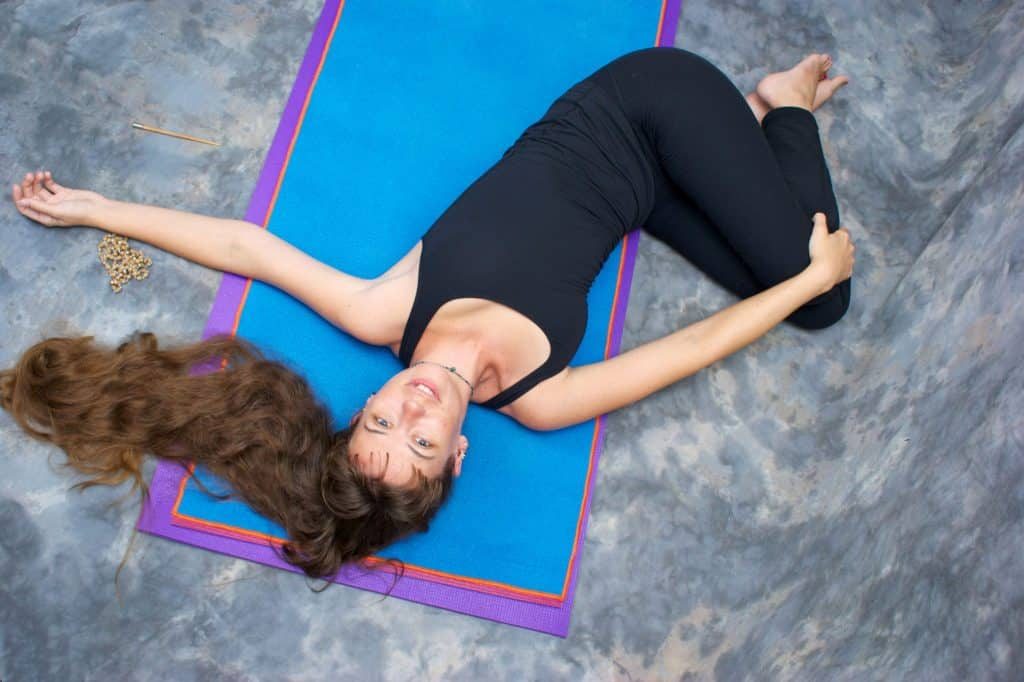
Variations: Again, there aren’t many variation options here, but one you can try if the stretch is a bit strong is placing a block or folded blanket between your knees, creating a bit more space between them.
You can also keep one leg straight and bend the other knee over the top of it, instead of both knees.
Corpse Pose (Savasana)
Every yoga session should finish with relaxation or meditation, and corpse pose is a fantastic go-to pose for this. Although just lying there might seem strange to an onlooker, it has some serious health benefits. It is a meditative pose that unwinds the whole body, calms the mind and relieves stress. It can also reduce headaches, fatigue and even insomnia, as well as potentially lowering blood pressure.
This one is pretty basic – lay flat on your back and let your feet flop to either side. Open your legs to at least hip-distance apart. Relax your arms either side of your body with your palms facing up. Close your eyes and relax into the pose, taking long, slow breaths.

Variations: If you have a sore lower back, you can place a bolster underneath your lower back to lift it slightly, or you can place a bolster underneath your knees, which helps relieve pressure on the lower back.




